Centauri Dreams
Imagining and Planning Interstellar Exploration
Science Fiction in Extreme Environments
I’ve had pulsars on the mind the last couple of days after our discussion of PSR 1257+12 and its contribution to exoplanetology. A bit more about pulsars today and the way we look at extreme objects through science fiction. PSR 1257+12 was discovered in 1990 by Aleksander Wolszczan using data from the Arecibo dish, and it was in 1992 that Wolszczan and Dale Frail published a paper outlining their discovery of the first planets ever found outside our Solar System. The two planets were joined by a third in 1994, but evidence for a fourth was later shown to be mistaken. In any case, the three planets confounded many astronomers, who hardly expected the first extrasolar planets to be found orbiting a radiation-spewing neutron star.
Centauri Dreams regular Al Jackson was co-author of a 1992 study of PSR1257+12 that examined orbital resonance in the planets around the pulsar. In a note last night, Al mused “Just think of a K2 civilization setting up a research station on one of those to study a pulsar – maybe someone has written the SF story?” I can’t think of a story specifically targeting a pulsar planet, though if memory serves, Alastair Reynolds deals with a pulsar in one of the early Revelation Space novels. But the notion reminds me of other extreme environment classics like Hal Clement’s Mission of Gravity (1954), which covers the fantastically spinning world Mesklin, where surface gravity gets up close to 700 g at the poles (the complete Mesklin material is available in the collection Heavy Planet: The Classic Mesklin Stories, an Orb title from 2002).
High-energy environments are made to order for hard science fiction. Consider what our best authors might do with this: The pulsar IGR J11014-6103, now the subject of observations by the Chandra X-Ray Observatory, is producing a jet of high-energy particles that this Chandra news release claims is the longest of any object in the Milky Way, a whopping 37 light years. The pulsar is moving away from a supernova remnant in the constellation of Carina at a speed somewhere between 1100 and 2200 kilometers per second, making it one of the fastest moving pulsars yet observed.
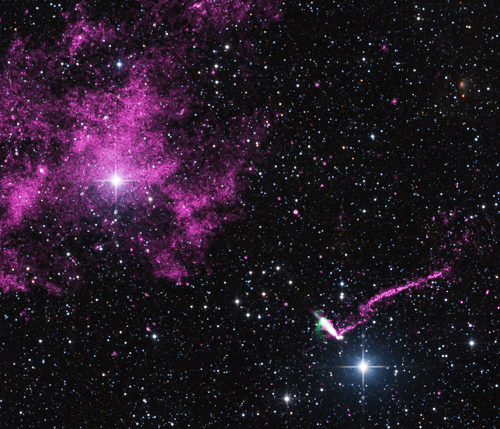
Image: An extraordinary jet trailing behind a runaway pulsar is seen in this composite image that contains data from NASA’s Chandra X-ray Observatory (purple), radio data from the Australia Telescope Compact Array (green), and optical data from the 2MASS survey (red, green, and blue). The pulsar – a spinning neutron star – and its tail are found in the lower right of this image. The tail stretches for 37 light years, making it the longest jet ever seen from an object in the Milky Way galaxy. Credit: X-ray: NASA/CXC/ISDC/L.Pavan et al, Radio: CSIRO/ATNF/ATCA Optical: 2MASS/UMass/IPAC-Caltech/NASA/NSF.
A 37 light-year jet is remarkable enough (nine times the distance to Proxima Centauri!), but we also find that there is a corkscrew pattern in the jet suggesting that the pulsar is wobbling as it spins. In addition, it’s producing a comet-like tail behind it due to the effects of a pulsar wind nebula (PWN) — a sheath of high-energy particles that enshrouds the pulsar. And while a pulsar’s direction of motion is usually aligned with its jet and the pulsar wind nebula around it, IGR J11014-6103’s own PWN is almost perpendicular to the direction of the jet, possibly indicating high rotation speeds in the iron core of the supernova that produced the pulsar.
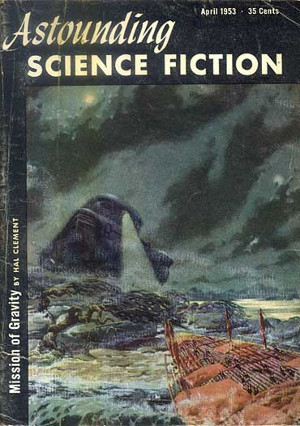
It’s fascinating to explore such extreme environments, and one of the things I love about science fiction is that a combination of scientific rigor and imagination can let us see things like this up close. Clement’s Mesklin was put together using a carefully wrought model that the author went on to describe in an article called ‘Whirligig World,’ which ran in Astounding Science Fiction in June of 1953. He based it on an object then believed to exist in the 61 Cygni system, and although the latter turned out to be a chimera, his concern for getting the science right built a memorable world we can still enjoy reading about today. Now who will take up Al Jackson’s challenge to describe a research station on a pulsar planet?
Image: The April, 1953 issue of Astounding contained the first installment of Hal Clement’s Mission of Gravity, published in book form the following year.
The paper on the light jet is Pavan et al. “The long helical jet of the Lighthouse nebula, IGR J11014-6103,” Astronomy & Astrophysics 562 (2014): A122 (preprint). Al Jackson’s paper on PSR 1257+12 is Malhotra et al. “Resonant orbital evolution in the putative planetary system of PSR1257 + 12,” Nature 356 (16 April 1992), pp. 583-585 (abstract).

Tau Boötis b: A ‘3-D’ Look at Star and Planet
Strong evidence for water in the atmosphere of the hot Jupiter Tau Boötis b has turned up, thanks to work by Geoffrey Blake (Caltech) and graduate student Alexandra Lockwood. But what’s intriguing about the find isn’t the water — we’ve found water vapor on other planets — but the method of detection. Lockwood and Blake used a modified radial velocity technique that has previously been deployed to detect low mass ratio binary stars. A top-flight instrument like the Near Infrared Echelle Spectrograph (NIRSPEC) at the W. M. Keck Observatory in Hawaii can separate the planetary and stellar components spectroscopically to produce this result.
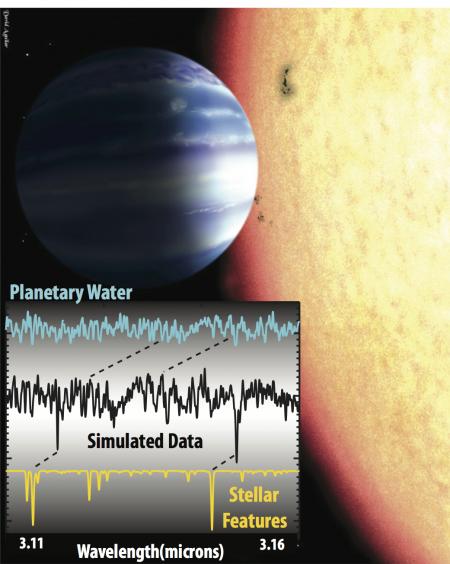
Image: Simulated data showing the method used for detecting water vapor features around the hot Jupiter tau Boötis b. In this example, the planetary signal has been increased in strength by several orders of magnitude relative to the actual signal. The dotted lines show the blue- and red-shifts of the planetary and stellar lines in the data, respectively. Credit: Alexandra Lockwood/Caltech.
Thus the toolkit of exoplanet science continues to grow. We already know how to study planetary atmospheres when a planet transits its primary as seen from Earth, allowing us to separate direct light from the star from light that has passed through the atmosphere. Another way of studying an atmosphere is through direct imaging, but here we rely on planets far enough from their host star that we can separate them from the star’s glare, the classic problem of planet hunters. But a non-transiting world like Tau Boötis b demands a different approach, and the spectroscopic separation of radial velocity signals appears to be one solution.
Lockwood is lead author of the paper on this work, which appears in The Astrophysical Journal Letters:
“The information we get from the spectrograph is like listening to an orchestra performance; you hear all of the music together, but if you listen carefully, you can pick out a trumpet or a violin or a cello, and you know that those instruments are present. With the telescope, you see all of the light together, but the spectrograph allows you to pick out different pieces; like this wavelength of light means that there is sodium, or this one means that there’s water.”
It was back in 2012 that two independent teams studying Tau Boötis b were able to separate the radial velocity of the planet from that of the star by studying shifts in the spectral lines of carbon dioxide. The technique as expanded into the infrared now gives us the molecular signature of water. I should mention here that a team in 2010 detected carbon monoxide in the atmosphere of another hot Jupiter, the much studied HD 209458 b, a detection that provided what researchers call the ‘spectroscopic orbit’ of the system and thus revealed the true mass of the planet.
So more is at play here than the detection of yet another component of a hot Jupiter’s atmosphere. Separating the two radial velocity components helps to determine a planet’s mass, which in earlier radial velocity studies could only be an estimate of the planet’s minimum mass. The actual mass could be much higher than what astronomers could measure, given their lack of knowledge about the inclination of the planet to the star. By detecting a signature from both planet and star, this method allows us to explore the system in greater detail. From the paper (with reference to the 2012 work on carbon dioxide mentioned above):
…this technique can be applied to non-transiting, RV-detected exoplanets to extract the unknown inclination and true mass. CRIRES [the High-Resolution IR Echelle Spectrometer installed at ESO’s Very Large Telescope] was also used to detect CO on τ Boötis b (Brogi et al. 2012), the first ground-based detection of a short-period non-transiting exoplanet atmosphere, a result confirmed shortly thereafter by Rodler et al. (2012). These studies provide the true mass of the planet and probe the chemical composition of its atmosphere. A combination of high signal-to-noise, high spectral resolution, and coverage of multiple CO overtone lines was required to achieve the sensitivity required for these detections.
So by finding the signature of water in the atmosphere of Tau Boötis b, the Caltech team is also extending work that creates what Lockwood calls the ‘3-D motion of the star and the planet in the system.’ It’s a method that deepens our understanding of the planetary system by giving us a true mass reading, and although at present its applications are limited to close-in gas giants like Tau Boötis b around nearby bright stars, the hope is that improvements in telescopes and infrared spectroscopy will extend the method to smaller planets around dimmer stars.
“While the current state of the technique cannot detect earthlike planets around stars like the Sun, with Keck it should soon be possible to study the atmospheres of the so-called ‘super-Earth’ planets being discovered around nearby low-mass stars, many of which do not transit,” adds Blake. “Future telescopes such as the James Webb Space Telescope and the Thirty Meter Telescope (TMT) will enable us to examine much cooler planets that are more distant from their host stars and where liquid water is more likely to exist.”
The paper is Lockwood et al. “”Near-IR Direct Detection of Water Vapor in tau Boötis b,” The Astrophysical Journal Letters, published online 24 February 2014 (preprint).

A Formation Mechanism for Pulsar Planets?
CSIRO, the Commonwealth Scientific and Industrial Research Organisation in Australia, is announcing the detection of violent events around the pulsar PSR J0738-4042, some 37,000 light years from Earth in the constellation Puppis. This southern hemisphere constellation was originally part of a larger constellation called Argo Navis, depicting the ship made famous by the journey of Jason and the Argonauts. But Argo Navis was divided into three smaller constellations, leaving Puppis (The Stern) as something of a mythological fragment.
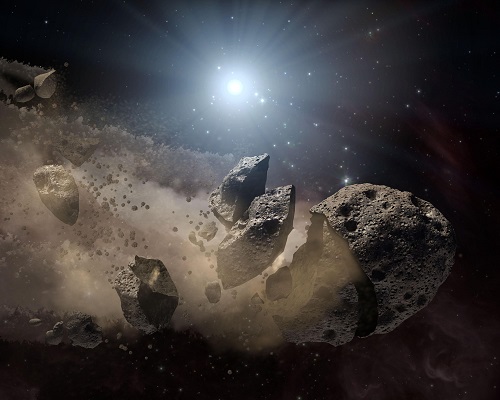
Image: An artist’s impression of an asteroid breaking up. Credit: NASA/JPL-Caltech.
Whatever its origins, Puppis is also home, from our Earthly perspective, to a pulsar around which radiation and sleeting high energy particles are common. Ryan Shannon, a member of the CSIRO research team, has previously examined how an infalling asteroid from a violent disk around a pulsar might affect it, slowing the pulsar’s spin rate and affecting the shape of the radio pulse that we see on Earth. That’s a useful signal, because pulsars flash a radio beam with great regularity, so that any disruptions call attention to themselves. Says Shannon:
“That is exactly what we see in this case. We think the pulsar’s radio beam zaps the asteroid, vaporising it. But the vaporised particles are electrically charged and they slightly alter the process that creates the pulsar’s beam.”
Long term monitoring has shown that the pulse shape of PSR J0738-4042 changes multiple times between 1988 and 2012, with one event that implies a rock of about a billion tonnes interacting with the pulsar. The abstract of the paper on this work summarizes the finding:
The torque, inferred via the derivative of the rotational period, changes abruptly from 2005 September. This change is accompanied by an emergent radio component that drifts with respect to the rest of the pulse. No known intrinsic pulsar processes can explain these timing and radio emission signatures.
And so we get an interesting mechanism for the formation of large objects around a pulsar. Dust and debris formed in the original stellar explosion that gave birth to the pulsar itself could fall back toward the spinning remnant to create a debris disk that, in turn, gives birth to larger objects. Recall that two planet-sized objects were detected in 1992 around the pulsar PSR 1257+12, though not necessarily formed by the same mechanisms (a third planet was detected five years later). We have much to learn about the various ways pulsar planets may form.
The environment that spawns these results has to give us pause. “If a large rocky object can form here,” Ryan Shannon adds, “planets could form around any star.” True enough, though we should add that pulsar planets still seem to be the rarest of the breed. In any case, this detection is remarkable. We’re reaching out to a distance far larger than that between the Earth and the galactic core to track conditions in this system. With so many ongoing projects, we can all too easily become blasé about just what is happening here, but let’s keep that sense of wonder at full throttle. Twenty-five years ago we had no confirmed exoplanets, and now we’re investigating asteroids in a system 37,000 light years from Earth? A golden era of discovery indeed…
The paper is Brook et al., “Evidence of an Asteroid Encountering a Pulsar,” Astrophysical Journal Letters Vol. 780, No. 2 (2014), L31 (abstract).

Extraterrestrial Dispersal Vectors
If human civilization is to extend itself beyond our planet, it will need to take with it the plants, animals and microorganisms that can sustain a living ecosystem. Nick Nielsen argues in this compelling essay that preserving our own species into the remote future thus means preserving terrestrial biology as well, drawing sustenance from it and maintaining it long enough for Earthly systems — and ourselves — to evolve in the myriad environments that await us among the stars. Mr. Nielsen’s examination of future speciation continues his ongoing series on existential risk and the nature of human expansion. You can keep up with his thinking on his two blogs: Grand Strategy: The View from Oregon and Grand Strategy Annex, or follow him on Twitter, where he is @geopolicraticus.
by J. N. Nielsen

Some time ago on Twitter I wrote, “Astrobiology is island biogeography writ large.” As in the classic science fiction film This Island Earth, we know our world to be an island oasis of life in the midst of a dark and possibly barren cosmic ocean of space. Astrobiology, in seeking to understand the place of life in the universe, seeks to understand our oasis of life in a cosmological context. Perhaps we will be forced to reconcile ourselves with an unrelieved cosmic loneliness; perhaps we will find that life is plentiful in the universe; perhaps life will be found to be so plentiful that it seems likely that life on earth is a consequence of panspermia. Whatever the result of our search, whatever remarkable discoveries we make, complex multicellular life like ourselves is likely to require some kind of homeworld for its initial evolution, and these worlds are likely to be distributed across widely separated worlds. Astrobiology is the cosmic biogeography that can serve as the field guide to this archipelago of habitable worlds.

The existence of galactic habitable zones (GHZ) and circumstellar habitable zones (CHZ) [1] implies regions of greater and lesser habitability, and the distribution of stars, planets, moons and other matter within the GHZ and CHZ implies worlds of greater and lesser habitability. A recent paper on Superhabitable Worlds [2] has suggested that there may be planets or planetary systems more clement to life than the environment of Earth. This implies the possibility that, although Earth looks like a unique oasis in the darkness of space, it may represent a cosmic region of sub-optimal habitability. At very least, we have much to learn about habitability, given the present necessity of extrapolating from a single data point. It seems, however, than in spite of our ignorance of life elsewhere in the cosmos we must first attempt to map the habitable zones of the universe if we are to search for the life that would supervene upon these habitable zones. The resulting patterns of habitability and life that we will eventually be able to map will be our biogeography of the cosmos – a kind of biocosmography or bioastrography – and we will want to consider the relationship between forms of life that occur at nodal points of habitability, if there are any such relationships.
Biogeographers in discussions of species distribution distinguish between stepping-stones routes, single-step routes, and sweepstakes routes of species dispersal. A stepping-stones route is a gradual process that is integral with the evolution of a species, which expands its range as its population grows, slowly covering a landscape. A single-step route is when, “organisms cross a barrier in a direct, single event, not sequentially.” [3] A sweepstakes route is dispersal via a vector that is rare and unusual. Many islands are eventually colonized by sweepstakes routes, which accounts for their distinctive flora and fauna. A lizard that happens to ride a floating log to an island and finds another lizard of the same species with which to perpetuate the species has experienced a sweepstakes dispersal route. Mostly on islands, one finds insects and birds and marine mammals, and few larger species that cannot fly or swim to the island under their own power.
Astrobiology will need to make similar distinctions among cosmological stepping-stones routes, single-step routes, and sweepstakes routes. We have already begun to understand some of the potential dispersal vectors. We know that a certain amount of matter is exchanged between the planets of our solar system, and it is possible that microorganisms have hitched a ride between planets on rocks blasted off the surface of a planet by some enormous impact. Under conditions prevailing in our solar system, however, we cannot expect that complex multicellular life could expand from our homeworld in this way.
In a superhabitable world or solar system, as noted above, it might be possible for complex, multicellular organisms to follow a stepping-stones route to dispersal beyond their homeworld, and thereby attain a far higher degree of existential viability than they would enjoy if they had remained an autochthonous species of a single celestial body. Apart from superhabitable worlds, on sub-optimally habitable worlds the scenario of single-celled microorganisms living on a piece of ejected debris that eventually finds itself on a celestial body other than its homeworld would constitute a paradigm case of a sweepstakes route.
It is possible to imagine circumstances of superhabitable worlds or even superhabitable solar systems in which the means provided by industrial-technological civilization are not necessary to the dispersal of life to other worlds, and a single-step route may be facilitated by naturally occurring means. In our perhaps sub-optimally habitable solar system, however, this is not possible. For the complex, multicellular life that we know and love on Earth, the only method of extraterrestrial dispersion would be a single-step route, the only dispersal vector would be a spacecraft, and the only way to produce a spacecraft is through a relatively advanced industrial-technological civilization.
Thus the long term existential viability of the terrestrial biosphere is predicated upon the growth and expansion of industrial-technological civilization, which seems paradoxical. In the early stages of industrial-technological civilization, up to and including the present day, the expansion of industrial-technological civilization has come at a cost to the terrestrial biosphere. It has even been suggested that another mass extinction is taking place, an anthropogenic mass extinction, as a result of human activity on Earth. Nevertheless, a vital technological civilization is, at least in our solar system, a necessary prerequisite to the survival of any life derived from the terrestrial biosphere once the Earth passes its natural span of habitability.
It is not only human beings that benefit from space travel and settlement; existential risk mitigation affects every living thing on Earth. If human beings establish a permanent and self-sustaining presence off the surface of the Earth, such an outpost of terrestrial life could only achieve a self-sustaining ecosystem through the parallel presence of thousands if not millions of other terrestrial species (keeping in mind that the majority of these species will be microorganisms, millions of terrestrial species do not necessarily impose insuperable spatial requirements for an off-world settlement). When we go into space, we must take with us the plants and animals that we eat or otherwise rely upon for our existential viability.
If we fail to utilize the resources of our industrial-technological civilization to lift ourselves and our fellow terrestrial species off the Earth, all that has been achieved by the terrestrial biosphere will be lost (i.e., it is not only humanity and civilization that are lost should we succumb to existential risk), except for the possibility of some extremophile microorganisms that might ultimately survive the dissolution of the Earth’s biosphere if blasted into space.
The natural lifespan of the Earth will eventually lapse and come to an end, and after that the natural lifespan of the sun, too, will be exhausted and lapse, which is why Wernher von Braun said, “The importance of the space program is to build a bridge to the stars, so that when the Sun dies, humanity will not die. The Sun is a star that’s burning up, and when it finally burns up, there will be no Earth… no Mars… no Jupiter.” [4] While his expression of the idea is anthropocentric, we can see that any bridge to the stars must also be a bridge for other terrestrial species as well as ourselves. In short, interstellar travel is a dispersal vector for terrestrial biology.
Once our terrestrial biology is extended to other worlds – initially, other worlds in our solar system, and then other worlds orbiting other stars – it will be subject to unprecedented selection pressures, and in the long term these selection pressures will result in speciation specific to the new environments in which terrestrial species gain a foothold. In other words, terrestrial life will continue to evolve, and it will evolve on other worlds in a way that it does not and would not evolve on Earth. Speciation on a cosmic scale will be the result. We do not know and cannot predict the direction that life will take in its adaptive radiation throughout the cosmos.
It will not be until the first terrestrial seeds are planted in lunar soil in a greenhouse on the moon, or in Martian soil in a greenhouse on Mars, that we will know what terrestrial plants grow well in these soils and under these conditions. Only experience can teach us this, as the interaction of organism and environment, especially under novel conditions, is too complex to predict with certainty, and life is a paradigm of contingency, subject to the thousand natural shocks that flesh is heir to.
If this ignorance of the consequences of space settlement for our own biology sounds like I am making light of our knowledge and abilities – after all, human beings have been farmers for more than ten thousand years – the idea is precisely analogous to another challenge faced by space travel. We do not yet know, and cannot predict on the basis of present knowledge of science, technology, and engineering, what technologies will prove to be the most robust forms of propulsion for interstellar vessels. Among the many concepts for interstellar propulsion that have been proposed there remains not only all the science yet to be done to confirm or invalidate the concept, but also the building of specific technologies on the basis of this science, engineering particular vehicles employing these specific technologies, and then the testing and proving of these vehicles in the kind of conditions that will only be faced in flight. In the same way, we do not yet know what terrestrial plants and animals will prove to be robust partners in space exploration.
We may eventually treat our food supply and sustainable ecosystem as an engineering problem, but that will compound rather than limit the unknowns of speciation. Because of our anthropocentric moral standards, we will likely have less moral compunction about modifying other species for their use on space settlements or other worlds; even then, species modified for our use in artificial environments (i.e., on shipboard and space settlements) or on other worlds (initially, Mars and moons in our solar system, and then other planets around other stars) will be subject to a twofold selection process that is only likely to accelerate their adaptive radiation, viz. these two selection pressures being the artificial selection resulting from human genetic engineering of other species and the natural selection of novel environments not encountered by any terrestrial species that remains on Earth.
Notes
[1] Cf. e.g., Astrobiology of Earth: The emergence, evolution, and future of life on a planet in turmoil, Joseph Gale, Oxford: Oxford University Press, 2009, p. 33
[2] Superhabitable Worlds, Heller, René and Armstrong, John. Astrobiology. January 2014, 14 (1): 50-66. doi:10.1089/ast.2013.1088.
[3] Trans-oceanic dispersal and evolution of early composites (Asteraceae) Liliana Katinas, Jorge V. Crisci, Peter Hoch, Maria C. Tellería, María J. Apodaca, Perspectives in Plant Ecology, Evolution and Systematics, Volume 15, Issue 5, 20 October 2013, Pages 269-280
[4] This was quoted by Friedwardt Winterberg at the Icarus Interstellar Starship Congress, Day 2; I have been unable to locate a source for this quote.

PLATO: Planet Hunter Selected by ESA
Following up on yesterday’s post on Gaia, it seems a good time to discuss PLATO, the European Space Agency’s planet hunting mission, which has just been selected for launch by ESA’s Science Policy Committee. The agency’s Cosmic Vision program has already selected the Euclid mission to study dark energy (launch in 2020) and Solar Orbiter, an interesting attempt to study the solar wind from less than fifty million kilometers. Solar Orbiter will surely return data we’ll want to discuss here in terms of magsails, electric sails and other ways to harness a solar wind about which we have much to learn.
Solar Orbiter’s launch is the closest of the three, scheduled for 2017, with PLATO pegged for 2024, the launch to be from the European spaceport in Kourou (French Guiana) aboard a Soyuz booster. Note that date, because it’s expected, as this BBC story notes, that the ground-based European Extremely Large Telescope (E-ELT) will be operational in Chile by 2024, a reminder that it should be powerful enough, with its 39-meter primary mirror, to carry out studies of planetary atmospheres as determined by targets PLATO can provide.
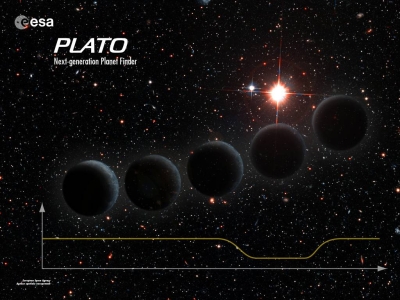
The mission will operate from the L2 Lagrangian point 1.5 million kilometers from the Earth, from which vantage PLATO will turn 34 individual telescopes and cameras on to a field of view that encompasses half the sky. Up to a million stars will be under investigation, looking for the characteristic lightcurve of a planet transiting the star as seen from Earth. PLATO will also have a strong asteroseismology component, allowing even more precision in characterizing its planetary finds, especially since these will be followed up with ground-based radial velocity observations that will benefit from having data on surface pulsations on target stars.
Thus PLATO’s unravelled acronym: PLAnetary Transits and Oscillations of stars. The ultimate goals are exactly those we’d expect: To discover and characterize relatively nearby planetary systems, detecting Earth-sized planets and ‘super-Earths’ in the habitable zone around solar-type stars while measuring solar oscillations in the host stars. Working at optical wavelengths, PLATO should be able to determine planetary mass with a precision of 10 percent, planetary radius with a precision of 2 percent and stellar age up to 10 percent.
The BBC quotes Don Pollacco (University of Warwick, leader of the PLATO Science Consortium), on how the mission differs from those that have gone before:
“PLATO will be our first attempt to find nearby habitable planets around Sun-like stars that we can actually examine in sufficient detail to look for life. Nearly all the small transiting planets discovered so far have been beyond our technology to characterise. PLATO will be a game-changer, allowing many Earth-like planets to be detected and confirmed and their atmospheres examined for signs of life.”
The contrast is, of course, with Kepler, whose stars — in a magnitude range between 7 and 17 — were faint enough that follow-up studies for the majority of candidates are difficult if not impossible. The interesting Lost in Transits blog, written by a PhD student at the University of Warwick and thus likely connected with Don Pollacco at the same school, points out that Kepler’s wide field and large camera array will be turned to brighter stars (magnitude 4-16) with equipment sufficient to follow up even small Earth-class planets around these stars. The blog also points to the effectiveness of asteroseismology in this work:
This ability to survey bright stars also allows astronomers to perform extremely sensitive measurements of the stars themselves. By using variations in starlight caused by ripples on the star’s surface, astronomers can accurately pin down not only the size of the star but also the age of the star system. This means, not only can Plato find exoplanets around bright stars, but it can also determine the size and age of many of these planets to a precision only previously dreamed of.
Ahead for PLATO are further refinements and finalization of the design, along with selection of an industrial prime contractor and, within the next two years, the final adoption of the mission, but the support given by the ESA Science Policy Committee, unanimous, strengthens our hopes that PLATO will fly. The fudge factor in that statement simply reflects the disappointments we’ve seen on both sides of the Atlantic with missions like SIM (Space Interferometry Mission) and the Darwin astronomical interferometer all showing promise only to face cancellation. Budgetary realities are always to be reckoned with, but PLATO’s selection is welcome news indeed.
For more detail on PLATO, see Rauer et al., “The PLATO 2.0 Mission” (abstract).

Chemical Change in a Protoplanetary Disk
The young star known as L1527 offers a spectacular view at infrared wavelengths, a result of the configuration of gas and dust around it. Have a look at the image below, taken by the Spitzer Space Telescope, where light from the star escapes through the opening provided by a bipolar gas flow, illuminating the gas to highlight a nebula in the shape of a butterfly. Earlier radio studies of this star have shown that L1527 is surrounded by a gas disk that, from our perspective, is seen edge-on. Now new radio observations are helping us characterize the gas itself.
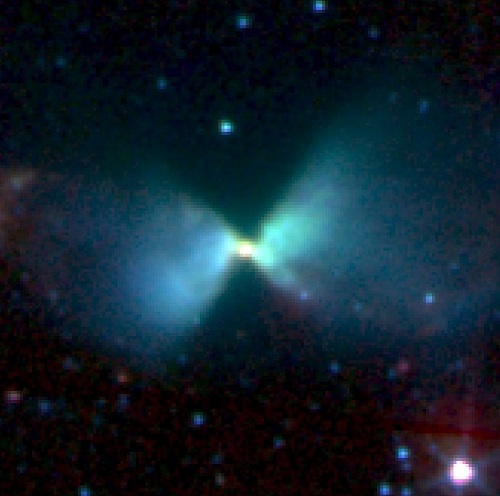
Image: An infrared image of the protostar L1527 taken by the Spitzer Space Telescope. Credit: J. Tobin/NASA/JPL-Caltech.
It’s an interesting investigation because the chemical changes inside a disk as it forms are little understood. Intense observational effort has gone into studying the physical structure of protoplanetary disks, but separating the young disk and the infalling envelope of gas and dust that gives rise to it is difficult. This is where the powerful sensitivity of ALMA (Atacama Large Millimeter/submillimeter Array, a radio interferometer array in Chile’s Atacama desert) may come to our aid. The new work, described in this news release from the University of Tokyo, is built around ALMA’s high spatial resolution observations to study the chemistry of disk formation.
Invisible in infrared light, the gas around L1527 can be readily examined at ALMA’s wavelengths, its molecules characterized in terms of their density, temperature and chemical composition. Researchers under Nami Sakai (University of Tokyo) have been studying the radio emission from cyclic-C3H2 (three carbon atoms in a loop-like structure with two hydrogen atoms attached) and sulfur monoxide (SO) molecules — these are emissions weak enough to be undetectable by other instruments, but within range of the ALMA array.
Because a new stellar system is formed through the gravitational collapse of interstellar materials, you would think that the interstellar gas and dust would simply be incorporated into the new disk structure as is. But Sakai and team have found something different: There is a chemical change associated with the formation of the disk. L1527’s disk has a radius of about 500 AU. Inside 100 AU, the emission from cyclic-C3H2 is weak enough to suggest chemical differentiation between the inner and outer disk. Meanwhile, SO seems to be concentrated in a ring-like structure with a radius of about 100 AU. The image below shows the result.
Image: L1527 observed by Spitzer (Left) and the distributions of cyclic-C3H2 (center) and SO (right) observed by ALMA. ALMA reveals the gas distribution just close to the protostar. Emission from cyclic-C3H2 is weak toward the protostar but strong at the northern and southern parts. Meanwhile, SO has its emission peak near the protostar. Credit: J. Tobin/NASA/JPL-Caltech, N. Sakai/The University of Tokyo.
So we have a striking change in chemical composition about 100 AU out. Sakai’s simulations show that infalling gas from the outer parts of the disk is piling up at what he calls the ‘centrifugal barrier.’ Local heating in this region as the infalling gas accumulates causes distinct chemical changes. Here I’m going to quote Masaaki Hiramatsu (NAOJ Chile Observatory), who put together a backgrounder on Sakai’s work, describing the lively action around this ‘barrier’:
The infalling gas collides with the barrier and is warmed up. SO molecules frozen on the surface of cold dust grains are liberated into the gas phase. The temperature decreases inside the barrier and the SO molecules are frozen again. This is the formation process of the SO ring at 100 AU. Rotating motion dominates inside the centrifugal barrier. Hence, the barrier is the edge of the disk formation region in which eventually a planetary system will be formed.
I’m not aware of earlier work on the chemical differences between protoplanetary disks and the interstellar clouds out of which they form, or of any earlier evidence for major changes in the chemistry of the disk as it emerges. It’s worth asking whether similar situations will be traced in other protoplanetary disks, something that only future observation will tell us, with inevitable implications for how our own Solar System formed if this turns out to be a common process. The paper suggests that micro-analyses of meteorites, spectroscopy of comets, and sample return from the asteroids will help us extend this study to our own system’s formation.
The paper is Sakai et al., “Change in the chemical composition of infalling gas forming a disk around a protostar,” published online in Nature 12 February 2014 (abstract).



